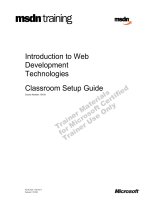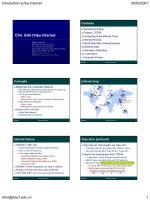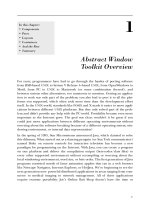Tài liệu Introduction to oracle 9i : SQL ppt
Bạn đang xem bản rút gọn của tài liệu. Xem và tải ngay bản đầy đủ của tài liệu tại đây (12.52 MB, 442 trang )
Introduction to Oracle9i: SQL
Student Guide • Volume 1
40049GC10
Production 1.0
June 2001
D33051
Copyright © Oracle Corporation, 2000, 2001. All rights reserved.
This documentation contains proprietary information of Oracle Corporation. It is
provided under a license agreement containing restrictions on use and disclosure and
is also protected by copyright law. Reverse engineering of the software is prohibited.
If this documentation is delivered to a U.S. Government Agency of the Department of
Defense, then it is delivered with Restricted Rights and the following legend is
applicable:
Restricted Rights Legend
Use, duplication or disclosure by the Government is subject to restrictions for
commercial computer software and shall be deemed to be Restricted Rights software
under Federal law, as set forth in subparagraph (c)(1)(ii) of DFARS 252.227-7013,
Rights in Technical Data and Computer Software (October 1988).
This material or any portion of it may not be copied in any form or by any means
without the express prior written permission of Oracle Corporation. Any other copying
is a violation of copyright law and may result in civil and/or criminal penalties.
If this documentation is delivered to a U.S. Government Agency not within the
Department of Defense, then it is delivered with “ Restricted Rights,” as defined in
FAR 52.227-14, Rights in Data-General, including Alternate III (June 1987).
The information in this document is subject to change without notice. If you find any
problems in the documentation, please report them in writing to Education Products,
Oracle Corporation, 500 Oracle Parkway, Box SB-6, Redwood Shores, CA 94065.
Oracle Corporation does not warrant that this document is error-free.
Oracle and all references to Oracle products are trademarks or registered trademarks
of Oracle Corporation.
All other products or company names are used for identification purposes only, and
may be trademarks of their respective owners.
Authors
Nancy Greenberg
Priya Nathan
Technical Contributors
and Reviewers
Josephine Turner
Anna Atkinson
Don Bates
Marco Berbeek
Andrew Brannigan
Michael Gerlach
Sharon Gray
Rosita Hanoman
Mozhe Jalali
Sarah Jones
Charbel Khouri
Christopher Lawless
Diana Lorentz
Nina Minchen
Cuong Nguyen
Daphne Nougier
Patrick Odell
Laura Pezzini
Stacey Procter
Maribel Renau
Bryan Roberts
Sunshine Salmon
Casa Sharif
Bernard Soleillant
Ruediger Steffan
Karla Villasenor
Andree Wheeley
Lachlan Williams
Publisher
Sheryl Domingue
Preface
Curriculum Map
Introduction
Objectives I-2
Oracle9i I-3
Oracle9i Application Server I-5
Oracle9i Database I-6
Oracle9i: Object Relational Database Management System I-8
Oracle Internet Platform I-9
System Development Life Cycle I-10
Data Storage on Different Media I-12
Relational Database Concept I-13
Definition of a Relational Database I-14
Data Models I-15
Entity Relationship Model I-16
Entity Relationship Modeling Conventions I-17
Relating Multiple Tables I-19
Relational Database Terminology I-20
Relational Database Properties I-21
Communicating with a RDBMS Using SQL I-22
Relational Database Management System I-23
SQL Statements I-24
Tables Used in the Course I-25
Summary I-26
1 Writing Basic SQL SELECT Statements
Objectives 1-2
Capabilities of SQL SELECT Statements 1-3
Basic SELECT Statement 1-4
Contents
iii
Selecting All Columns 1-5
Selecting Specific Columns 1-6
Writing SQL Statements 1-7
Column Heading Defaults 1-8
Arithmetic Expressions 1-9
Using Arithmetic Operators 1-10
Operator Precedence 1-11
Using Parentheses 1-13
Defining a Null Value 1-14
Null Values in Arithmetic Expressions 1-15
Defining a Column Alias 1-16
Using Column Aliases 1-17
Concatenation Operator 1-18
Using the Concatenation Operator 1-19
Literal Character Strings 1-20
Using Literal Character Strings 1-21
Duplicate Rows 1-22
Eliminating Duplicate Rows 1-23
SQL and iSQL*Plus Interaction 1-24
SQL Statements versus iSQL*Plus Commands 1-25
Overview of iSQL*Plus 1-26
Logging In to iSQL*Plus 1-27
The iSQL*Plus Environment 1-28
Displaying Table Structure 1-29
Interacting with Script Files 1-31
Summary 1-34
Practice 1 Overview 1-35
iv
2 Restricting and Sorting Data
Objectives 2-2
Limiting Rows Using a Selection 2-3
Limiting the Rows Selected 2-4
Using the WHERE Clause 2-5
Character Strings and Dates 2-6
Comparison Conditions 2-7
Using Comparison Conditions 2-8
Other Comparison Conditions 2-9
Using the BETWEEN Condition 2-10
Using the IN Condition 2-11
Using the LIKE Condition 2-12
Using the NULL Conditions 2-14
Logical Conditions 2-15
Using the AND Operator 2-16
Using the OR Operator 2-17
Using the NOT Operator 2-18
Rules of Precedence 2-19
ORDER BY Clause 2-22
Sorting in Descending Order 2-23
Sorting by Column Alias 2-24
Sorting by Multiple Columns 2-25
Summary 2-26
Practice 2 Overview 2-27
v
3 Single-Row Functions
Objectives 3-2
SQL Functions 3-3
Two Types of SQL Functions 3-4
Single-Row Functions 3-5
Character Functions 3-7
Case Manipulation Functions 3-9
Using Case Manipulation Functions 3-10
Character-Manipulation Functions 3-11
Using the Character-Manipulation Functions 3-12
Number Functions 3-13
Using the ROUND Function 3-14
Using the TRUNC Function 3-15
Using the MOD Function 3-16
Working with Dates 3-17
Arithmetic with Dates 3-19
Using Arithmetic Operators with Dates 3-20
Date Functions 3-21
Using Date Functions 3-22
Practice 3, Part 1 Overview 3-24
Conversion Functions 3-25
Implicit Data-Type Conversion 3-26
Explicit Data-Type Conversion 3-28
Using the TO_CHAR Function with Dates 3-31
Elements of the Date Format Model 3-32
Using the TO_CHAR Function with Dates 3-36
vi
vii
Using the TO_CHAR Function with Numbers 3-37
Using the TO_NUMBER and TO_DATE Functions 3-39
RR Date Format 3-40
Example of RR Date Format 3-41
Nesting Functions 3-42
General Functions 3-44
NVL Function 3-45
Using the NVL Function 3-46
Using the NVL2 Function 3-47
Using the NULLIF Function 3-48
Using the COALESCE Function 3-49
Conditional Expressions 3-51
The CASE Expression 3-52
Using the CASE Expression 3-53
The DECODE Function 3-54
Using the DECODE Function 3-55
Summary 3-57
Practice 3, Part 2 Overview 3-58
4 Displaying Data from Multiple Tables
Objectives 4-2
Obtaining Data from Multiple Tables 4-3
Cartesian Products 4-4
Generating a Cartesian Product 4-5
Types of Joins 4-6
Joining Tables Using Oracle Syntax 4-7
What Is an Equijoin? 4-8
Retrieving Records with Equijoins 4-9
Additional Search Conditions Using the AND Operator 4-10
Qualifying Ambiguous Column Names 4-11
Using Table Aliases 4-12
Joining More than Two Tables 4-13
Nonequijoins 4-14
Retrieving Records with Nonequijoins 4-15
Outer Joins 4-16
Outer Joins Syntax 4-17
Using Outer Joins 4-18
Self Joins 4-19
Joining a Table to Itself 4-20
Practice 4, Part 1 Overview 4-21
Joining Tables Using SQL: 1999 Syntax 4-22
Creating Cross Joins 4-23
Creating Natural Joins 4-24
Retrieving Records with Natural Joins 4-25
Creating Joins with the USING Clause 4-26
Retrieving Records with the USING Clause 4-27
Creating Joins with the ON Clause 4-28
Retrieving Records with the ON Clause 4-29
Creating Three-Way Joins with the ON Clause 4-30
INNER versus OUTER Joins 4-31
LEFT OUTER JOIN 4-32
RIGHT OUTER JOIN 4-33
viii
FULL OUTER JOIN 4-34
Additional Conditions 4-35
Summary 4-36
Practice 4, Part 2 Overview 4-37
5 Aggregating Data Using Group Functions
Objectives 5-2
What Are Group Functions? 5-3
Types of Group Functions 5-4
Group Functions Syntax 5-5
Using the AVG and SUM Functions 5-6
Using the MIN and MAX Functions 5-7
Using the COUNT Function 5-8
Using the DISTINCT Keyword 5-10
Group Functions and Null Values 5-11
Using the NVL Function with Group Functions 5-12
Creating Groups of Data 5-13
Creating Groups of Data: GROUP BY Clause Syntax 5-14
Using the GROUP BY Clause 5-15
Grouping by More Than One Column 5-17
Using the GROUP BY Clause on Multiple Columns 5-18
Illegal Queries Using Group Functions 5-19
Excluding Group Results 5-21
Excluding Group Results: The HAVING Clause 5-22
Using the HAVING Clause 5-23
Nesting Group Functions 5-25
Summary 5-26
Practice 5 Overview 5-27
ix
6 Subqueries
Objectives 6-2
Using a Subquery to Solve a Problem 6-3
Subquery Syntax 6-4
Using a Subquery 6-5
Guidelines for Using Subqueries 6-6
Types of Subqueries 6-7
Single-Row Subqueries 6-8
Executing Single-Row Subqueries 6-9
Using Group Functions in a Subquery 6-10
The HAVING Clause with Subqueries 6-11
What Is Wrong with This Statement? 6-12
Will This Statement Return Rows? 6-13
Multiple-Row Subqueries 6-14
Using the ANY Operator in Multiple-Row Subqueries 6-15
Using the ALL Operator in Multiple-Row Subqueries 6-16
Null Values in a Subquery 6-17
Summary 6-18
Practice 6 Overview 6-19
7 Producing Readable Output with iSQL*Plus
Objectives 7-2
Substitution Variables 7-3
Using the & Substitution Variable 7-5
Character and Date Values with Substitution Variables 7-7
Specifying Column Names, Expressions, and Text 7-8
x
Defining Substitution Variables 7-10
DEFINE and UNDEFINE Commands 7-11
Using the DEFINE Command with & Substitution Variable 7-12
Using the VERIFY Command 7-14
Customizing the iSQL*Plus Environment 7-15
SET Command Variables 7-16
iSQL*Plus Format Commands 7-17
The COLUMN Command 7-18
Using the COLUMN Command 7-19
COLUMN Format Models 7-20
Using the BREAK Command 7-21
Using the TTITLE and BTITLE Commands 7-22
Creating a Script File to Run a Report 7-23
Sample Report 7-25
Summary 7-26
Practice 7 Overview 7-27
8 Manipulating Data
Objectives 8-2
Data Manipulation Language 8-3
Adding a New Row to a Table 8-4
The INSERT Statement Syntax 8-5
Inserting New Rows 8-6
Inserting Rows with Null Values 8-7
Inserting Special Values 8-8
Inserting Specific Date Values 8-9
xi
Creating a Script 8-10
Copying Rows from Another Table 8-11
Changing Data in a Table 8-12
The UPDATE Statement Syntax 8-13
Updating Rows in a Table 8-14
Updating Two Columns with a Subquery 8-15
Updating Rows Based on Another Table 8-16
Updating Rows: Integrity Constraint Error 8-17
Removing a Row from a Table 8-18
The DELETE Statement 8-19
Deleting Rows from a Table 8-20
Deleting Rows Based on Another Table 8-21
Deleting Rows: Integrity Constraint Error 8-22
Using a Subquery in an INSERT Statement 8-23
Using the WITH CHECK OPTION Keyword on DML Statements 8-25
Overview of the Explict Default Feature 8-26
Using Explicit Default Values 8-27
The MERGE Statement 8-28
MERGE Statement Syntax 8-29
Merging Rows 8-30
Database Transactions 8-32
Advantages of COMMIT and ROLLBACK Statements 8-34
Controlling Transactions 8-35
Rolling Back Changes to a Marker 8-36
Implicit Transaction Processing 8-37
State of the Data Before COMMIT or ROLLBACK 8-38
State of the Data After COMMIT 8-39
xii
Committing Data 8-40
State of the Data After ROLLBACK 8-41
Statement-Level Rollback 8-42
Read Consistency 8-43
Implementation of Read Consistency 8-44
Locking 8-45
Implicit Locking 8-46
Summary 8-47
Practice 8 Overview 8-48
9 Creating and Managing Tables
Objectives 9-2
Database Objects 9-3
Naming Rules 9-4
The CREATE TABLE Statement 9-5
Referencing Another User’ s Tables 9-6
The DEFAULT Option 9-7
Creating Tables 9-8
Tables in the Oracle Database 9-9
Querying the Data Dictionary 9-10
Data Types 9-11
Datetime Data Types 9-13
TIMESTAMP WITH TIME ZONE Data Type 9-15
TIMESTAMP WITH LOCAL TIME Data Type 9-16
INTERVAL YEAR TO MONTH Data Type 9-17
Creating a Table by Using a Subquery Syntax 9 -18
xiii
Creating a Table by Using a Subquery 9-19
The ALTER TABLE Statement 9-20
Adding a Column 9-22
Modifying a Column 9-24
Dropping a Column 9-25
The SET UNUSED Option 9-26
Dropping a Table 9-27
Changing the Name of an Object 9-28
Truncating a Table 9-29
Adding Comments to a Table 9-30
Summary 9-31
Practice 9 Overview 9-32
10 Including Constraints
Objectives 10-2
What Are Constraints? 10-3
Constraint Guidelines 10-4
Defining Constraints 10-5
The NOT NULL Constraint 10-7
The UNIQUE Constraint 10-9
The PRIMARY KEY Constraint 10-11
The FOREIGN KEY Constraint 10-13
FOREIGN KEY Constraint Keywords 10-15
The CHECK Constraint 10-16
Adding a Constraint Syntax 10-17
Adding a Constraint 10-18
Dropping a Constraint 10-19
xiv
Disabling Constraints 10-20
Enabling Constraints 10-21
Cascading Constraints 10-22
Viewing Constraints 10-24
Viewing the Columns Associated with Constraints 10-25
Summary 10-26
Practice 10 Overview 10-27
11 Creating Views
Objectives 11-2
Database Objects 11-3
What Is a View? 11-4
Why Use Views? 11-5
Simple Views and Complex Views 11-6
Creating a View 11-7
Retrieving Data from a View 11-10
Querying a View 11-11
Modifying a View 11-12
Creating a Complex View 11-13
Rules for Performing DML Operations on a View 11-14
Using the WITH CHECK OPTION Clause 11-17
Denying DML Operations 11-18
Removing a View 11-20
Inline Views 11-21
Top-n Analysis 11-22
Performing Top-n Analysis 11-23
xv
Example of Top-n Analysis 11-24
Summary 11-25
Practice 11 Overview 11-26
12 Other Database Objects
Objectives 12-2
Database Objects 12-3
What Is a Sequence? 12-4
The CREATE SEQUENCE Statement Syntax 12-5
Creating a Sequence 12-6
Confirming Sequences 12-7
NEXTVAL and CURRVAL Pseudocolumns 12-8
Using a Sequence 12-10
Modifying a Sequence 12-12
Guidelines for Modifying a Sequence 12-13
Removing a Sequence 12-14
What Is an Index? 12-15
How Are Indexes Created? 12-16
Creating an Index 12-17
When to Create an Index 12-18
When Not to Create an Index 12-19
Confirming Indexes 12-20
Function-Based Indexes 12-21
Removing an Index 12-22
Synonyms 12-23
xvi
Creating and Removing Synonyms 12-24
Summary 12-25
Practice 12 Overview 12-26
13 Controlling User Access
Objectives 13-2
Controlling User Access 13-3
Privileges 13-4
System Privileges 13-5
Creating Users 13-6
User System Privileges 13-7
Granting System Privileges 13-8
What Is a Role? 13-9
Creating and Granting Privileges to a Role 13-10
Changing Your Password 13-11
Object Privileges 13-12
Granting Object Privileges 13-14
Using the WITH GRANT OPTION and PUBLIC Keywords 13-15
Confirming Privileges Granted 13-16
How to Revoke Object Privileges 13-17
Revoking Object Privileges 13-18
Database Links 13-19
Summary 13-21
Practice 13 Overview 13-22
14 SQL Workshop Workshop Overview
Workshop Overview 14-2
xvii
15 Using SET Operators
Objectives 15-2
The SET Operators 15-3
Tables Used in This Lesson 15-4
The UNION SET Operator 15-7
Using the UNION Operator 15-8
The UNION ALL Operator 15-10
Using the UNION ALL Operator 15-11
The INTERSECT Operator 15-12
Using the INTERSECT Operator 15-13
The MINUS Operator 15-14
SET Operator Guidelines 15-16
The Oracle Server and SET Operators 15-17
Matching the SELECT Statements 15-18
Controlling the Order of Rows 15-20
Summary 15-21
Practice 15 Overview 15-22
16 Oracle 9i Datetime Functions
Objectives 16-2
TIME ZONES 16-3
Oracle 9i Datetime Support 16-4
CURRENT_DATE 16-6
CURRENT_TIMESTAMP 16-7
LOCALTIMESTAMP 16-8
DBTIMEZONE and SESSIONTIMEZONE 16-9
xviii
EXTRACT 16-10
FROM_TZ 16-11
TO_TIMESTAMP and TO_TIMESTAMP_TZ 16-12
TO_YMINTERVAL 16-13
TZ_OFFSET 16-14
Summary 16-16
Practice 16 Overview 16-17
17 Enhancements to the GROUP BY Clause
Objectives 17-2
Review of Group Functions 17-3
Review of the GROUP BY Clause 17-4
Review of the HAVING Clause 17-5
GROUP BY with ROLLUP and CUBE Operators 17-6
ROLLUP Operator 17-7
ROLLUP Operator Example 17-8
CUBE Operator 17-9
CUBE Operator: Example 17-10
GROUPING Function 17-11
GROUPING Function: Example 17-12
GROUPING SETS 17-13
GROUPING SETS: Example 17-15
Composite Columns 17-17
Composite Columns: Example 17-19
Concatenated Groupings 17-21
xix
Concatenated Groupings Example 17-22
Summary 17-23
Practice 17 Overview 17-24
18 Advanced Subqueries
Objectives 18-2
What Is a Subquery? 18-3
Subqueries 18-4
Using a Subquery 18-5
Multiple-Column Subqueries 18-6
Column Comparisons 18-7
Pairwise Comparison Subquery 18-8
Nonpairwise Comparison Subquery 18-9
Using a Subquery in the FROM Clause 18-10
Scalar Subquery Expressions 18-11
Correlated Subqueries 18-14
Using Correlated Subqueries 18-16
Using the EXISTS Operator 18-18
Using the NOT EXISTS Operator 18-20
Correlated UPDATE 18-21
Correlated DELETE 18-24
The WITH Clause 18-26
WITH Clause: Example 18-27
Summary 18-29
Practice 18 Overview 18-31
xx
19 Hierarchical Retrieval
Objectives 19-2
Sample Data from the EMPLOYEES Table 19-3
Natural Tree Structure 19-4
Hierarchical Queries 19-5
Walking the Tree 19-6
Walking the Tree: From the Bottom Up 19-8
Walking the Tree: From the Top Down 19-9
Ranking Rows with the LEVEL Pseudocolumn 19-10
Formatting Hierarchical Reports Using LEVEL and LPAD 19-11
Pruning Branches 19-13
Summary 19-14
Practice 19 Overview 19-15
20 Oracle 9i Extensions to DML and DDL Statements
Objectives 20-2
Review of the INSERT Statement 20-3
Review of the UPDATE Statement 20-4
Overview of Multitable INSERT Statements 20-5
Types of Multitable INSERT Statements 20-7
Multitable INSERT Statements 20-8
Unconditional INSERT ALL 20-10
Conditional INSERT ALL 20-11
Conditional FIRST INSERT 20-13
Pivoting INSERT 20-15
External Tables 20-18
xxi
Creating an External Table 20-19
Example of Creating an External Table 20-20
Querying External Tables 20-23
CREATE INDEX with CREATE TABLE Statement 20-24
Summary 20-25
Practice 20 Overview 20-26
A Practice Solutions
B Table Descriptions and Data
C Using SQL* Plus
D Writing Advanced Scripts
E Oracle Architectural Components
Index
Additional Practices
Additional Practice Solutions
Table and Descriptions
xxii
Preface
Preface-3
Profile
Before You Begin This Course
Before you begin this course, you should be able to use a graphical user interface (GUI).
Required prerequisites are familiarity with data processing concepts and techniques.
How This Course Is Organized
Introduction to Oracle9i: SQL is an instructor-led course featuring lectures and hands-on
exercises. Online demonstrations and written practice sessions reinforce the concepts and
skills introduced.









